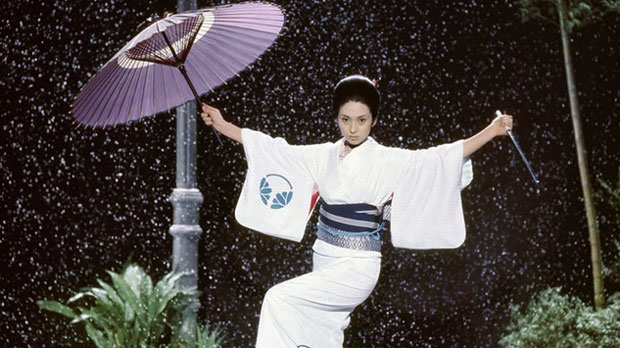 Lady Snowblood (1973) Toho Films/Action RT: 97 minutes No MPAA rating (strong graphic bloody violence, sexual content, brief nudity, language) Director: Toshiya Fujita Screenplay: Norio Osada Music: Masaaki Hirao Cinematography: Masaki Tamura Release date: March 22, 1974 (US) Cast: Meiko Kaji, Toshio Kurosawa, Masaaki Daimon, Miyoko Akaza, Shinichi Uchida, Takeo Chii, Noboru Nakaya, Yoshiko Nakada, Akemi Negishi, Kaoru Kusuda, Sanae Nakahara, Hosei Komatsu, Makoto Matsuzaki, Hiroshi Hasegawa, Eiji Okada, Ko Nishimura. Box Office: N/A Spoken in Japanese w/English subtitles
Lady Snowblood (1973) Toho Films/Action RT: 97 minutes No MPAA rating (strong graphic bloody violence, sexual content, brief nudity, language) Director: Toshiya Fujita Screenplay: Norio Osada Music: Masaaki Hirao Cinematography: Masaki Tamura Release date: March 22, 1974 (US) Cast: Meiko Kaji, Toshio Kurosawa, Masaaki Daimon, Miyoko Akaza, Shinichi Uchida, Takeo Chii, Noboru Nakaya, Yoshiko Nakada, Akemi Negishi, Kaoru Kusuda, Sanae Nakahara, Hosei Komatsu, Makoto Matsuzaki, Hiroshi Hasegawa, Eiji Okada, Ko Nishimura. Box Office: N/A Spoken in Japanese w/English subtitles
Rating: *** ½
Like any movie geek worth his weight in popcorn, I have certain titles that I like to watch as double features. Mine include Five Deadly Venoms/Master of the Flying Guillotine, Double Team/Maximum Risk and Thriller: A Cruel Picture/Lady Snowblood. That last one is inspired by Quentin Tarantino who references both pictures in his Kill Bill duology. The titular heroine in the period martial arts film Lady Snowblood is the primary inspiration for Lucy Liu’s heartless assassin O-Ren Ishii in the first Kill Bill. Nobody pays tribute to obscure movies like good old QT. If not for him, I never would have known Lady Snowblood even existed.
Based on the manga series by Kazuo Koike, Lady Snowblood is a tale that unfolds in non-chronological order. Yuki Kashima (Kaji, Female Prisoner 701: Scorpion) is a “child of the netherworld”, a child born for vengeance. Her sole purpose in life is to find and kill the four criminals who brutally raped her mother after murdering her husband and son twenty years earlier.
Of the four malefactors who took part in the crime, only three are still among the living. Yuki’s mother took care of the other one, stabbing him in the back during sex, an action that gets her sentenced to life in prison. It’s where she conceives and gives birth to Yuki. It was her final wish that her daughter take up the mantle of revenge when she comes of age. She spends her whole childhood training under the harsh tutelage of the priest Dokai (Nishimura) until she’s ready to undertake her mission of revenge. He relentlessly trains her in martial arts and sword fighting. He turns her into a total bad ass.
This is all background information woven through the narrative as flashback scenes. The movie proper opens with a cool scene of Yuki confronting and killing a corrupt official with a sword concealed in the handle of her umbrella. She uses it as leverage to make Matsuemon (Takagi), the leader of a network of street beggars, use his connections to track down her remaining targets- Takemura Banzo (Nakaya), Tsukamoto Gishiro (Okada) and Kitahama Okono (Nakahara). When he provides her with their current whereabouts, she heads off to settle the score.
The only other thing I’m willing to reveal about the plot of Lady Snowblood is the newspaper reporter Ryurei Ashio (Kurosawa) who decides to publish a fictionalized version of Yuki’s story in order to lure one of the intended targets out of hiding. I’ll also say that Yuki’s murderous actions incur the wrath of Kobue (Nakada), the daughter of one of the targets. That’s it. I wouldn’t want to spoil the greatness in store for any new viewers.
Lady Snowblood is excellent. There’s no better way to say it. It has a great story, plentiful action, balletic fight choreography and a heroine who’s equal parts beautiful and deadly. Our first glimpse of Yuki is her sandaled little foot stepping in snow on the sidewalk. This shot definitely influenced the climactic fight scene between O-Ren and The Bride in the first Kill Bill. Yuki moves as gracefully as a ballerina and as fast as a snake. She might look delicate, but looks can be deceiving. This girl is seriously deadly. She has impressive physical prowess. She leaps around and over her opponents. She swings from a lamp wire between two balconies. She’s not intimidated by anything. When Ryurei is abducted by one of the targeted criminals, she makes short work of the guards patrolling the grounds of the estate where he’s being held. The violence in Lady Snowblood is literally showered in blood red. When Yuki cuts her opponents with her sword, blood sprays from the wounds in abundance. It happens often. At one point, she cuts somebody in half.
Kaji does a great job as Yuki, a deadly but not completely emotionless killer. The scene where she tearfully visits her mother’s grave is proof. She’s a heroine ahead of her time. In the early 70s, female-led action movies weren’t the norm. I would have loved to see Kaji, who works primarily in the Asian film market, do some American actioners. She’s so neat!
I don’t understand why Lady Snowblood didn’t attain classic status. It’s AWESOME! It’s completely period authentic (19th century Japan), beautifully filmed and well acted. It has a wonderful score and a sad, beautiful theme song. It’s practically flawless. I owe QT a great big debt of gratitude for bringing it to my attention.




